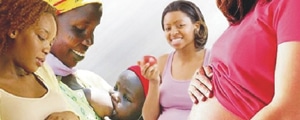
Annually, 16 million girls aged between 15 and 19 give birth. 90% of the births in developing countries occur in adolescent marriages according to World Health Organisation (WHO) statistics. In many countries, the risk of maternal death is twice as high for adolescent mothers.
Motherhood is often a fulfilling experience, but sadly it is commonly associated with severe health consequences without proper care, education and support. Conditions that are related to pregnancy and childbirth are the second cause of death among women of reproductive age.
Severe bleeding, infections, unsafe abortion and high blood pressure conditions are four of the main killers that cause 70% of deaths. In all, over 358 000 women die per year and most of these are preventable.
20 million pregnancy complications Maternal health simply refers to the overall health of a woman during pregnancy, childbirth and the postpartum period. More than 136 million women give birth per year and about 20 million of them experience pregnancy-related complications. Maternal health or the lack of it is a major public health crisis.
It is important to know that the bleeding after a delivery can kill even a healthy woman if unattended. The risk of death is directly related to the access and availability of proper healthcare services. Generally, access to services is related to the income of the family or individual. Less income generally equates to less access to care and greater risk of death or complication.
Women who are attended by trained healthcare professionals are rarer than you think. Nearly half of all childbirths in developing countries are not attended to properly. Attended childbirths still pose the risk of complications such as infections if cleanliness and hygiene standards are not strictly adhered to.
Unsafe abortion and infant death There are over 18 million unsafe abortions that are carried out every year that result in over 46 000 deaths. Half of these abortions are considered unsafe.
WHO defines unsafe abortion as a “procedure for terminating a pregnancy that is performed by an individual lacking the necessary skills, or in an environment that does not conform to minimal medical standards, or both”.
- Chamisa under fire over US$120K donation
- Mavhunga puts DeMbare into Chibuku quarterfinals
- Pension funds bet on Cabora Bassa oilfields
- Councils defy govt fire tender directive
Keep Reading
It is estimated that three-quarters of newborn deaths could be prevented if women were adequately nourished and received appropriate medical care from early pregnancy through the post-delivery period. Currently, about four million infants die within their first month. Improved access to medical care and maternal nutrition would significantly reduce stillbirths, which now number 3,3 million worldwide.
Many women in developing countries give birth before the age of 18. Many of these women have been married off as children and lack the education, money, and status to get adequate healthcare services.
Complications run rampant in adolescent pregnancies. Children having children will face substantial risk from having small pelvises that can obstruct labour resulting in long labor times, birth injuries and an increased risk of stillborn babies.
Education highest priority Experts at the World Health Organisation point to education as the primary way of addressing maternal health in many developing countries. Education can address the root causes poverty, low status of females and lack of access to healthcare.
The education of girls and young women does a lot more than just improving the lives of mothers; it protects children’s health, facilitates healthy families, creates less of a burden on healthcare delivery systems and overall improves society.
- This column is directed by your questions, comments and inquiries. Please email [email protected] for additional information.











